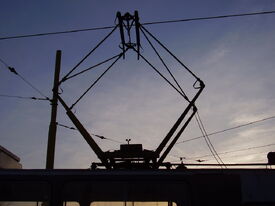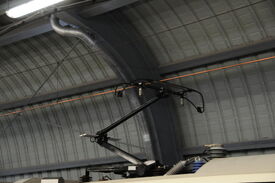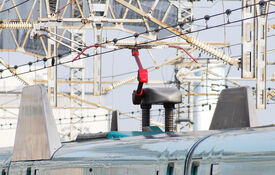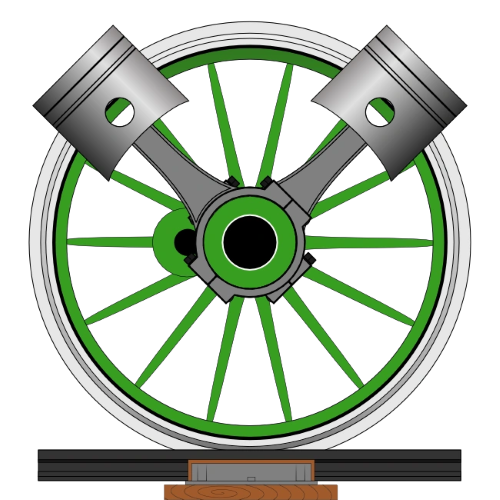
An example of a lozenge-type or scissor arm pantograph.

A single arm pantograph as seen on a Siemens Desiro 360/2.

A high-speed single arm pantograph as seen on a E5 Series Shinkansen.
A pantograph is a device for collecting an electrical current to power an electric locomotive or electric multiple unit. The system is employed to make contact with an electrified overhead wire (cable). Pantographs come in all shapes and sizes depending on the speed of the locomotive or train set, power requirements, power supply systems etc. The basic parts of a pantograph is a lower arm(s) that pivot against the roof, of a carriage/loco, and is attached to upper arm(s) that is in-turn attached to a collector 'head' or 'pan'. The head is the only part of the pantograph to touch the wire pick-up. The current is collected via metalized carbon strips on the head.
Low-speed pantographs[]
Low-speed pantographs operate below 125 mph (200 km/h). These systems use springs and air-pressure to do most of the operations. When folded down to the roof of the carriage/loco the 'up' springs are in the stretched position. The method of raising the pantograph starts with letting air into a cylinder, called the 'operating cylinder', this moves a piston forward, and pulls the control rod and moving a slotted link to control the process. Then the springs take over and lift the head (via leverage) to contact with the wire. The reason for having the air cylinder, is to compress the 'down' spring. To lower the pantograph, air is exhausted from the cylinder and the 'down' spring acts on the device to lower the head to the roof of the carriage/loco.
High-speed pantographs[]
For locomotives or trainsets that have a top-speed above approximately 125 mph (200 km/h) a different system is used. These have no springs, (since bouncing is a problem), and is raised by pressurized-air via a regulator. This is set to maintain a constant force on the overhead wire. When the height of the overhead wire falls, (such as entering a tunnel), air is bled from the system, and air is added when the train leaves the tunnel and the height of the overhead wire raises.
References[]
- Book: The Railway Data File published by Silverdale Books. ISBN: 1-85605-499-3.
